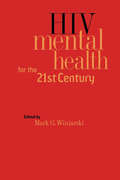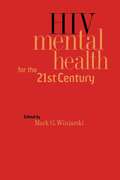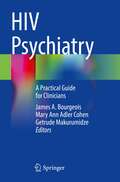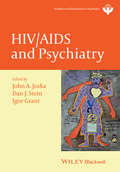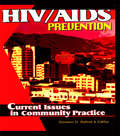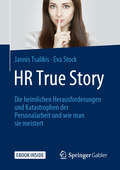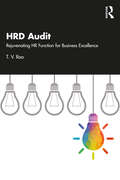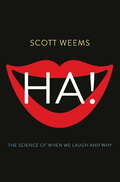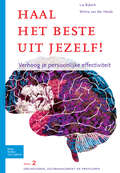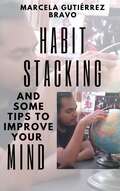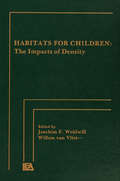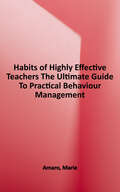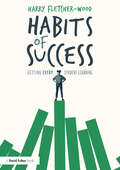- Table View
- List View
HIV & AIDS And The Older Adult
by Kathleen M. NokesFirst published in 1996. The incidence of HIV/AIDS in society has reached epidemic levels. People of all ages are contracting the disease, and with the advances in medication and treatment, those with the disease are living longer. This book discusses the unique issues facing older adults with HIV/AIDS and addresses living with the disease.
HIV Affected and Vulnerable Youth: Prevention Issues and Approaches
by Alejandro Garcia Susan Taylor-BrownHIV Affected and Vulnerable Youth: Prevention Issues and Approaches provides suggestions for support of vulnerable youth who must face chronic disease or death, poverty, drug abuse, and racism, as well as the tribulations that accompany adolescence. Social workers, case managers, psychologists, and nurses who work with HIV-affected and vulnerable youth and their families will find unique recommendations on how to assist these individuals in resisting risky behaviors. This unique collection of research studies expands on the current knowledge while informing us of how much more there is to be learned. This informative book will enlighten you about the children and mothers who are most likely to be affected by the HIV disease, the poor people of color living in substandard housing who are subjected to discrimination and social isolation. The multiple losses experienced by these women and children because of infection, crime, and substance abuse are included in this valuable book but most importantly you will discover how you can alleviate some of the stresses caused by these losses. Through HIV Affected and Vulnerable Youth, you will discover multiple ways to successfully help the adolescents in your practice deal with the challenges inherent to HIV, economic hardships, and substance abuse.Comprehensive and intelligent, this important book will help you address the needs of HIV-affected children or families with humanity, sensitivity, and ethnically sensitive interventions. With HIV Affected and Vulnerable Youth, you will find unique interventions to help the youth and family in your community by: discovering how facing the mortality of an HIV-infected family member has profound psychological effects on a child or adolescent and how you can help ease this crisis for your clients understanding why many youth who must cope with the eminent death of a family member deal with this crisis by engaging in risky behaviors which may result in HIV infection for themselves realizing that the lack of education about HIV, how it is transmitted, and how to prevent transmission may be part of the problem for high-risk youth learning how some HIV-positive children exhibit stable functioning and resilience in coping with their health, but have difficulties exhibiting the same stability in other aspects of their lives realizing that the social stigma surrounding HIV has not lost its intensity and that this stigma is a part of the everyday reality for HIV-affected children and their familiesHIV Affected and Vulnerable Youth: Prevention Issues and Approaches brings to light the daily heartache and struggles of HIV-affected children and their families. The day-to-day challenges of families and youths due to HIV-infection, crime, substance abuse, and sometimes where and how they live pose problems to the well-being of these individuals and are significant obstacles to mental-health therapy and health care services. This helpful book offers you several intervention techniques in order to improve the lives of HIV-affected individuals and families in your community.
HIV Mental Health for the 21st Century (Open Access Lib And Hc Ser.)
by Mark G. WiniarskiAs we approach the 21st century, we also approach the third decade of the AIDS epidemic. Mental health care providers must face the crucial fact that the human immunodeficiency virus (HIV) and the condition it causes, Acquired Immune Deficiency Syndrome (AIDS) is the leading cause of death among Americans aged 25-44 years. HIV Mental Health for the 21st Century provides a roadmap for mental health professionals who seek to develop new strategies aimed at increasing the longevity and quality of life for people living with HIV/AIDS, as well as at controlling the future spread of the disease. Divided into five sections, this volume covers basic concepts in HIV/AIDS mental health; specialized aspects of HIV/AIDS clinical care; models of clinical care; program evaluation; and HIV mental health policy and programs. Chapters treat issues such as feelings of caregivers, the role of spirituality in mental health care, rural practice, mental health home care, and working with children.
HIV Mental Health for the 21st Century (Open Access Lib And Hc Ser.)
by Mark G. WiniarskiAs we approach the 21st century, we also approach the third decade of the AIDS epidemic. Mental health care providers must face the crucial fact that the human immunodeficiency virus (HIV) and the condition it causes, Acquired Immune Deficiency Syndrome (AIDS) is the leading cause of death among Americans aged 25-44 years. HIV Mental Health for the 21st Century provides a roadmap for mental health professionals who seek to develop new strategies aimed at increasing the longevity and quality of life for people living with HIV/AIDS, as well as at controlling the future spread of the disease. Divided into five sections, this volume covers basic concepts in HIV/AIDS mental health; specialized aspects of HIV/AIDS clinical care; models of clinical care; program evaluation; and HIV mental health policy and programs. Chapters treat issues such as feelings of caregivers, the role of spirituality in mental health care, rural practice, mental health home care, and working with children.
HIV Psychiatry: A Practical Guide for Clinicians
by James A. Bourgeois Mary Ann Adler Cohen Getrude MakurumidzeThis book is a practical guide in understanding how to prevent HIV transmission, to recognize risk behaviors, and to add something else to their repertoires. It aims to empower clinicians and provide a sense of security and competence with the recognition and understanding of some of the psychiatric illnesses that complicate and perpetuate the HIV pandemic that continue to persist throughout every area of the world despite the magnitude of the progress that has transformed the illness from a rapidly fatal to chronic illness that is no longer life-limiting. Missing in most of the literature on HIV is the subtle, and sometimes not so subtle, contribution of psychiatric symptoms, psychiatric illness, and risk behaviors that drive the pandemic and serve as catalysts for new infections. This practical guide provides state-of-the-art understanding of not only prevention but also a way to recognize risk behaviors, psychiatric symptoms, and psychiatric illnesses that will demystify and decode the sometimes enigmatic and frustrating reasons for nonadherence with diagnostic procedures and life-saving treatments and care. All behaviors and pathology are covered as well as the resources and treatments available. The goal of this text is to refresh knowledge on the current state of psychiatric illness management among people living with HIV, to provide a concise volume on the psychiatric aspects of HIV prevention and treatment that substantially impact the overall care of the patient, and to help understand the psychiatric catalysts of the pandemicWritten by experts in the field, HIV Psychiatry: A Practical Guide for Clinicians provides enduring guidance to medical and other professionals caring for complicated clinical patients as they face ongoing challenges in working with persons with HIV and AIDS.
HIV Treatments as Prevention (TasP)
by Seth C. KalichmanHIV Treatment as Prevention: Primer for Behavior-Based Implementation provides the first practical guide to integrating behavioral prevention with antiretroviral therapies for people living with HIV infection. This brief book discusses the historical and social context embedding the shifting landscape in HIV prevention, where the use of effective treatments have become the focus of HIV prevention. While using treatments for prevention is promising, the history of HIV prevention offers several important pitfalls that must be avoided if HIV treatments are to ultimately succeed in preventing new HIV infections. Lessons learned from the successes and failures of other biomedical technologies used in HIV prevention, specifically syringes, condoms, and HIV testing are critical to the success of using HIV treatments for prevention. HIV Treatment as Prevention: Primer for Behavior-Based Implementation summarizes the scientific evidence for advancing the use of antiretroviral therapies for HIV prevention. The evidence makes clear that HIV treatments can prevent HIV transmission, but will fail if behavioral aspects of treatment and HIV transmission are ignored. Of greatest concern are medication adherence and risks for contracting other sexually transmitted infections. Placing HIV treatment within the context of behavioral interventions for maintaining medication adherence and reducing sexual risk behaviors is therefore essential to the future of HIV prevention. HIV Treatment as Prevention: Primer for Behavior-Based Implementation highlights two pioneering behavioral interventions aimed at maximizing the effects of antiretroviral therapies for preventing HIV transmission. One of the interventions, developed by the Author's research team, is discussed in detail and the intervention manual is included as an Appendix.
HIV and Gay Men: Clinical, Social and Psychological Aspects
by Rusi Jaspal Jake BayleyThis book focuses on the clinical, social and psychological aspects of HIV among gay men and examines the complex factors that can contribute to HIV risk in this key population. With the target to end all HIV transmissions in the UK by 2030 in mind, Jaspal and Bayley combine elements of HIV medicine and social psychology to identify the remaining barriers to effective HIV prevention among gay men. The authors take the reader on a journey through the history of HIV, its science and epidemiology and its future, demonstrating the vital role of history, society and psychology in understanding the trajectory of the virus. Underpinned by theories from social psychology and clinical snapshots from practice, this book considers how psychological constructs, such as identity, risk and sexuality, can impinge on physical health outcomes. This refreshing and thought-provoking text is an invaluable resource for scholars, clinicians and students working in the field of HIV.
HIV and Psychiatry
by Igor Grant Dan J. Stein John A. JoskaEditorsJohn A. JoskaDepartment of Psychiatry and Mental Health, University of Cape TownDan J. SteinDepartment of Psychiatry and Mental Health, University of Cape TownIgor GrantDepartment of Psychiatry, University of California, San DiegoMental health and HIV/AIDS are closely interlinked. Mental disorders, including substance-use disorders, are associated with increased risk of HIV infection and affect adherence to and efficacy of antiretroviral treatments. Conversely, HIV infection can increase risk for neuropsychiatric complications including stress, mood, and neurocognitive disorders. This book provides clinicians with a comprehensive evidenced-based and practical approach to the management of patients with HIV infection and co-morbid mental disorders. It provides up-to-date and clear overviews of current clinical issues, as well as the relevant basic science. Information and data from studies of different HIV groups (eg men who have sex with men) make the text relevant to a broad spectrum of clinicians, including those working with low socioeconomic status groups in high income countries and those working in the developing world.The book uses the popular format of the World Psychiatric Association's Evidence and Experience series. Review chapters summarize the evidence on the epidemiology, pathogenesis and clinical aspects of mental disorders in HIV,and interventions (both psychotherapy and psychopharmacology including drug-drug interactions). These are complemented by commentaries addressing particular facets of each topic and providing insight gained from clinical experience. Psychiatrists, psychologists and all mental health staff working with HIV-infected patients will find this book of great benefit.
HIV/AIDS Prevention: Current Issues in Community Practice
by Doreen D. SalinaDevelop a positive working relationship between researchers and community groups focusing on HIV/AIDS prevention, and discover how to evaluate HIV/AIDS programs! An indispensable manual for everyone involved with HIV/AIDS research, prevention techniques, and the needs of individuals with HIV/AIDS, HIV/AIDS Prevention: Current Issues in Community Practice covers everything from the likelihood of condom usage by college women to the psychological effects on minority men infected with the HIV/AIDS virus. Essential reading for psychologists, research scientists who work with communities or who are involved in AIDS prevention programs, and for care takers of people with HIV/AIDS, Contemporary Topics in HIV/AIDS Prevention covers the necessary collaborative steps needed to create a positive researcher/community based organization (COB) partnership that will benefit researchers and those affected by the disease. In HIV/AIDS Prevention, you will examine many different models designed to effectively foster a positive researcher/CBO relationship while learning how to overcome problems you may encounter when researching a social issue or working with a researcher. This book also explains how and why many HIV prevention programs have been poorly evaluated due to a lack of funds and social politics. In addition, you will discover how you can obtain and/or perform a true evaluation of an HIV prevention program. In HIV/AIDS Prevention, you will explore many important issues and factors that help create successful programs, including: factors necessary for valid HIV/AIDS prevention program evaluations assessments of coping strategies, psychological variables, and the physical well-being of African- American and Latino men living with HIV/AIDS steps for the collaborative process between researchers and community groups making a good match between community-based organizations and researchersHIV/AIDS Prevention gives you pertinent information and guidelines for selecting a community-based organization to work with and the steps to creating a successful relationship. This book will give you the strategies and information you need in order to give pastoral support and prevention education to at-risk individuals. You will discover what is necessary for a true HIV/AIDS prevention program evaluation.
HIV/AIDS and Sexuality
by Michael W RossIn this important book, editor Michael Ross brings together the latest knowledge and research concerning the relationship between HIV and AIDS and sexual functioning. HIV/AIDS and Sexuality explores the experiences of being HIV-infected and the impact of infection on an individual's sexuality. It describes differences that may be associated with individuals who are infected or concerned about infection, and it provides new in-depth analyses of the effect of HIV on sexuality and sexual risks. The book provides clinical perspectives on sexual problems associated with HIV infection as well as some treatment approaches. Contributing authors represent the United States, Australia, and Europe and discuss heterosexual men and women, gay men, lesbians, and injecting drug users. This diversity provides a more complete picture of the experiences of people with HIV in terms of explicit and implicit sexuality. Chapters include cross-sectional and cohort study designs as well as qualitative, quantitative, and clinical approaches. Some of the topics explored are:the centrality of sexuality to equality of life and identity and the impact of HIV on sexuality in gay-identified menthe psychological impact of making changes in sexual behavior on gay men with HIV infectionrisk behaviors in seropositive and seronegative womena study of a cohort of HIV-infected women associated with the militarysexual addiction in gay men and its association with HIV risksovert and subtle communications processes that occur between health care providers and clients about sexuality and HIVstages of change in safer sexual practices in a cohort of gay menpersonality variables associated with risk and infection in both homosexual and heterosexual menHIV/AIDS and Sexuality opens up the area of sexuality in people living with HIV and focuses much-needed attention on the issues involved in sexual expression, HIV transmission risk, and living with HIV infection. This book is an illuminating exploration into the subject that helps professionals better understand their clients and thus provide more compassionate and effective care.
HR True Story: Die heimlichen Herausforderungen und Katastrophen der Personalarbeit und wie man sie meistert
by Jannis Tsalikis Eva StockDieses Buch schildert ehrlich und schonungslos die Realität von Personalverantwortlichen In diesem Buch über Tabuthemen im Human Resources Management stellt Autor Jannis Tsalikis Geschichten zu folgenden Themen in anonymisierter Form vor:Alkohol und Drogen am ArbeitsplatzBeziehungen und sexuelle Verhängnisse in der BelegschaftDiebstahl und Betrug am ArbeitsplatzEntlassungen im kleinen und großen StilDiskriminierung und Mobbinguvm. Tsalikis behandelt in seinem Werk ausschließlich Fallbeispiele aus dem echten Personalerleben. Diese sind zum Teil im Berufsalltag des Autors passiert, teilweise stammen sie von Kollegen aus dem Personalmanagement. Mit vielen konkreten Praxistipps Das Buch erzählt aber nicht nur echte Geschichten aus der Praxis von Praktikern für Praktiker. Jannis Tsalikis geht zudem mit Unterstützung von Experten aus Arbeitsrecht und Psychologie auf konkrete Tipps zum Umgang mit schwierigen Mitarbeitern und vielen weiteren Herausforderungen im Personaleralltag ein.
HRD Audit: Rejuvenating HR Function for Business Excellence
by T. V. RaoThis book presents the first ever comprehensive approach to evaluating and redesigning Human Resource Development (HRD) function and intervention to maximise their contribution to business excellence.The HRD function recognises the significance of competent and committed people in helping organizations achieve excellence. Studies across the globe have indicated that good HR systems and practices go a long way to make firms effective. Competent employees, top management, HR staff and the HRD climate play a critical role. This book examines how users of HRD are partners in any review and evaluation. It uses multiple methods like interviews with stakeholders, observation, questionnaires, analysis of documents and workshops. The book also outlines key HRD audit methodologies to review and rejuvenate HRD and align it with business excellence including intellectual capital building for the long term.An incisive and invigorating read, this book would be useful to the students, researchers, line managers, CEOs, CXOs and faculty of Human Resource Management, Organizational Behaviour and Applied Psychology. It would also be an invaluable handbook for practising business executives to help them implement the performance management and other talent management systems for leading excellence.
HUMAN(e): A Radical Reimagining of Grief, Loss and Learning to Live Without
by Rachelle BensoussanWritten by a Queer woman of North African and Middle Eastern descent, Human(e) takes a radically non-pathology-based approach to grief and loss. In this intimate and reflective auto-ethnographic book, Bensoussan asserts that grief is a biological imperative; a life-sustaining necessity that is vital to our survival. Human(e) explores how our species has been living with, and metabolizing loss, well before there were licensed professionals and accredited institutions. Bensoussan examines the inadequacy of the idea that grief is normal, as grief goes well beyond the Western-colonial binary of normal and abnormal. Grief is human, and to grieve is to be human. Rachelle seamlessly and beautifully weaves together her vast professional expertise on grief with her own personal lived experiences of loss. Human(e) is a must read for anyone learning to live without.
Ha!: The Science of When We Laugh and Why
by Scott WeemsAn entertaining tour of the science of humor and laughter Humor, like pornography, is famously difficult to define. We know it when we see it, but is there any way to figure out what we really find funny? In this fascinating investigation into the science of humor and laughter, neuroscientist Scott Weems uncovers whatOCOs happening in our heads when we giggle, guffaw, or double over with laughter. Beginning with the premise that humor arises from inner conflict in the brain, Weems explores such issues as why surprise is so important for humor, why computers are terrible at recognizing whatOCOs funny, and why cringe-worthy stereotypes make us laugh the hardest. From the role of insult jokes to the benefit of laughing for our immune system responses, "Ha " reveals why humor is so idiosyncratic, and why how-to books alone will never help us become funnier people. Packed with the latest research, amusing anecdotes (and even a few jokes), "Ha " is a delightful tour of why humor is so important to our daily lives.
Ha, Ha And Aha: The Role Of Humour In Psychotherapy
by Harold H. Mosak, PhD.First published in 1987. Routledge is an imprint of Taylor & Francis, an informa company.
HaWoS – Fragebogen zur Erfassung von Glück bei der Arbeit: Manual (Manuale zu Testverfahren und Fragebögen)
by Ricarda Rehwaldt Timo KortschDie HappinessandWork-Scale (HaWoS) ist ein Verfahren, das Bedingungen für Glück bei der Arbeit erfasst. Es handelt sich um ein mehrdimensionales Instrument der Organisationsdiagnostik, das als Ausgangspunkt einer Förderung von Glück im Arbeitskontext dient. Die HAWOS misst das Glücksempfinden der Mitarbeitenden einer Organisation im Arbeitskontext über zwölf Items anhand der drei Faktoren des Arbeitsglücks: Sinnempfinden, Selbstverwirklichung und Gemeinschaftsgefühl. Die Items der HAWOS sind berufsbezogen formuliert, die Entwicklungs- und Validierungsstudien wurden an Personen mit Berufserfahrung durchgeführt. Hintergrund: Für Beschäftigte gewinnt eine erfüllende Arbeit immer mehr an Bedeutung. Die HaWoS setzt mit der Erfassung von glücksförderlichen Bedingungen bei der Arbeit genau dort an. Mit dem validierten HaWoS können Ansatzpunkte für die Gestaltung der Arbeit identifiziert werden und Interventionen evaluiert werden. Die Zielgruppen: Arbeits-, Wirtschafts- und Organisationspsycholog*innen Personalentwickler*innen Personalverantwortliche, Management, Führungskräfte Coaches Organisationsberater*innen EinsatzbereicheDie HaWoS kann im Individual- und im Gruppenkontext angewendet werden. Die HaWoS bildet dabei den Ausgangspunkt für Interventionen oder Entwicklungsprozesse mit dem Ziel einer glücksförderlicheren Arbeitsgestaltung. Die HaWoS kann außerdem in Transformationsprozessen eingesetzt werden, die einen Kulturwandel zu einer sinnhafteren Arbeit zum Ziel haben.Durchführung, Auswertung und Interpretation· Sehr gute Testökonomie: Bearbeitungszeit von max. 5 Minuten· Testdurchführungen erfolgt digital oder „paper-pencil“· Online-Auswertung direkt im Testsystem mit grafischen Ergebnissen auf einem intuitiv nutzbaren Dashboard Gütekriterien· Objektivität ist durch standardisierte Durchführung und Auswertung gewährleistet.· Reliabilität: Mit Werten zwischen = .77 und = .86 im guten Bereich.· Validität: Bestätigung der faktoriellen sowie der konvergenten Validität in mehreren Studien.· Normierung basierend auf einer Normstichprobe von 3353 Personen liegt vor.
Haal het beste uit jezelf!: Verhoog je persoonlijke effectiviteit
by Lia Bijkerk Wilma van der HeideHoe kunnen studenten maximaal gebruik maken van hun kwaliteiten en interesses tijdens hun opleiding, in stages, bij het afstuderen en tijdens het werk? Hoe kunnen studenten beter omgaan met stress en met de tijd? Hoe kunnen zij betere gesprekken leren voeren en effectiever samenwerken? Hoe onderscheiden zij zich van de anderen en kunnen zij innovatieve producten en diensten verzinnen? Allemaal vragen die studenten graag beantwoord zien tijdens hun opleiding om gerichte keuzes te kunnen maken en om zo efficiënt en effectief mogelijk te studeren.In dit tweede deel van het boek voor studenten wordt de theorie van nog acht thema’s in het kader van persoonlijke effectiviteit beknopt beschreven. De hoofdstukken zijn overzichtelijk ingedeeld met daarin een praktijkvoorbeeld afkomstig uit het hbo, de beschrijving van de algemene competentie waaraan gewerkt wordt en een leertekst met voorbeelden, tips, modellen, vuistregels, do’s en dont’s. De hoofdstukken eindigen met praktische opdrachten en een doorverwijzing naar specifieke literatuur of websites die ondersteunend kunnen werken.Op de, bij het boek behorende website, kunnen studenten de testen uit het boek maken en de benodigde bestanden voor hun portfolio downloaden. Met behulp van dit boek kunen studenten de algemene competenties: organiseren, zelfmanagement en profileren vergroten. Het boek kan gebruikt worden als hulpmiddel bij lessen in het kader van de studieloopbaanbegeleiding of als ondersteuning bij regiekring bijeenkomsten. Studenten kunnen het boek ook individueel doorwerken om het beste uit zichzelf te halen.
Habit Stacking and some Tips to Improve Your Mind
by Marcela Gutiérrez BravoThe enormous library that the internet represents in our times has made people in favor of and against its effects in our habits, behavior, and even brain structure. The fact is that they will never agree if it is beneficial or not, as the individuals in the world are varied, as are their needs, habits, ideologies, and other aspects. In such a small nucleus, like a family, there can be discrepancies concerning said quandary. The truth is that it exists, and it is the main tool of our time. However, heads of households, teachers, and other similar people concerned over the moral good that this tool influences, have come to prohibit it in several places; this seems sad to me, as this tool contains all of the human knowledge up to today, and it would be a betrayal to our advance as a humanity, denying us the right to enjoy this knowledge. That’s why I have collected in this book, and in those that will follow, only some of the best ideas that the majority of professionals will suggest, that are found on the internet. After being a website and self-help book translator from four languages to Spanish, I have realized that not all languages have the same information on the internet. I have noticed, also, that there is very valuable information out there, but it is found in specialized blogs or in very lengthy articles that few people wish to read in their short navigation routine. This is the reason that I decided to do this collection. A book has a different manner. It claims a distinct moment for itself, just like the one network navigation claims for itself. It usually, barely gives us time to read publications that interest us, or manage to distract us, or improve our mood, stressed by the crazy and unending movement of the times that we live in. To that end, I have tried to present the material in the most enjoyable way possible and in small chapters that are good for reading while waiting in line, in transportation, in the last minutes of t
Habitats for Children: The Impacts of Density
by Joachim F. Wohlwill and Willem van VlietFirst published in 1985. Routledge is an imprint of Taylor & Francis, an informa company.
Habits for Healing: Reclaim Your Purpose, Peace, and Power
by Nakeia HomerHeal your past, start fresh, and create a life that honors the truth of who you are today. A leading well-being educator empowers you to turn concepts like boundaries and self-care into practical rituals with the power to transform your life.&“A powerful roadmap to help you break free of outdated patterns.&”—Mel Robbins, New York Times bestselling author, host of The Mel Robbins Podcast&“Gives you the tools to realize that you are truly worthy of building habits for healing.&”—Jamie Kern Lima, New York Times bestselling author of Worthy, founder of IT CosmeticsAs a former counselor and social worker, Nakeia Homer has helped thousands of people see that the journey from surviving to thriving begins with your habits. In Habits for Healing, Nakeia Homer sheds light on simple, powerful acts that move us toward healing and help us to escape patterns of burnout, toxic relationships, and emotional exhaustion. Drawing on her work guiding others and her own experience of healing from a traumatic childhood, she helps readers find healing in their everyday rhythms. For example:• A drive home from work can become an opportunity for self-care• Keeping a daily to-do list is a surprising way to ease into acceptance• The practice of becoming curious about others&’ motivations frees us from taking their words personallyThrough soul-stirring storytelling, life-affirming advice, and prompts for reflection, Nakeia Homer holds space for readers to feel what they feel, uncover the source of their difficulties, and live in their true power. Written with warmth and deep insight, Habits for Healing is the next inspiring step on your mental health journey.
Habits of Highly Effective Teachers: The Ultimate Guide to Practical Behaviour Management That Works!
by Marie AmaroWhat do I do when students won't stop talking? <p>How can I stop students wasting time and disrupting other students? <p>What can I do about disrespectful students? Sound familiar? <p><p> Difficult student behaviours can keep you awake at night! Effective classroom management can feel elusive and you feel isolated and incompetent dealing with students. Problematic student behaviour can lead to teacher stress, frustration and yes, even tears. You didn't learn about this at uni! <p><p> If you dream of a classroom where you can get on with the business of teaching and learning without being interrupted by poor student behaviour, Habits of Highly Effective Teachers is the book for you. <p><p> Well-regarded trainer, speaker and author Marie Amaro, has over 30 years' experience in the classroom. As a teacher, she really understands the unique challenges that face teachers today, the difficulties and demands on teachers and how to provide solutions that are achievable and easily implemented. <p><p> Learn what good teachers do, so you can do it too! <p> <p>- How to establish clear expectations for behaviour in the classroom <p>- The secret to building rapport with students while maintaining appropriate boundaries <p>- How to reduce conflict with students through prevention and early intervention <p>- Simple ways to reinforce expected behaviour throughout the day <p>- How to skilfully redirect inappropriate student behaviour <p>- Highly practical teaching strategies to motivate and engage students
Habits of Success: Getting Every Student Learning
by Harry Fletcher-WoodFor students to benefit from lessons, they must attend, listen and try their best. But at times, almost all teachers struggle to manage classroom behaviour and to motivate students to learn. Drawing on decades of research on behavioural science, this book offers teachers practical strategies to get students learning. The key is students’ habits. This book reveals simple yet powerful ways to help students build habits of success. Harry Fletcher-Wood shows how teachers can use behavioural science techniques to increase motivation and improve behaviour. He offers clear guidance on topics such as using role models to motivate students, making detailed plans to help students act and building habits to ensure students keep going. The book addresses five challenges teachers face in encouraging desirable behaviour: Choosing what change to prioritise Convincing students to change Encouraging students to commit to a plan Making starting easy Ensuring students keep going Workshops, checklists and real-life examples illustrate how these ideas work in the classroom and make the book a resource to revisit and share. Distilling the evidence into clear principles, this innovative book is a valuable resource for new and experienced teachers alike.
Habits of Success: Getting Every Student Learning
by Harry Fletcher-WoodFor students to benefit from lessons, they must attend, listen, and try their best. But at times, almost all teachers struggle to manage classroom behavior, and to motivate students to learn. Drawing on decades of research on behavioral science, this book offers teachers practical strategies to get students learning. The key is students’ habits. This book reveals simple, powerful ways to help students build habits of success. Harry Fletcher-Wood shows how teachers can use behavioral science techniques to increase motivation and improve behavior. He offers clear guidance on topics such as using role models to motivate students, making detailed plans to help students act, and building habits to ensure students keep going. The book addresses five challenges teachers face in encouraging desirable behavior: Choosing what change to prioritize Convincing students to change Encouraging students to commit to a plan Making starting easy Ensuring students keep going Workshops, checklists and real-life examples illustrate how these ideas work in the classroom and make the book a resource to revisit and share. Distilling the evidence into clear principles, this innovative book is a valuable resource for new and experienced teachers alike.
Habits of the Creative Mind
by Richard E. Miller Ann JurecicHabits of the Creative Mind is not another textbook. Instead, Habits of the Creative Mind is a series of guideposts taking your students off the beaten path of five paragraph essays and rote responses. Portable and flexibly arranged, it works beautifully alone or as a supplement to other materials. In this refreshingly conversational volume, your students will learn to trust and refine their own thinking and improve their writing--at all skill levels. They will have access to Richard E. Miller's and Ann Jurecic's much acclaimed, truly unique approach to posing and exploring questions, and facing complexity--in which there are no limits to how far a student may go with his or her thinking and writing. Instantly accessible and instantly flexible, all your students need to do is dive in anywhere in the book and be ready to try something new. And throughout, they will benefit from innovative, manageable exercises--which may be completed in any order--to help them along the way. In the Framework for Success in Postsecondary Writing, the Council for Writing Program Administrators, the National Council of Teachers of English, and the National Writing Project all affirm the need to shift the emphasis in writing instruction to habits of mind. This book answers that call--and gives your students the tools they need to rise to the occasion.
Habits: Pragmatist Approaches from Cognitive Science, Neuroscience, and Social Theory
by Fausto Caruana Italo TestaThis book evaluates the potential of the pragmatist notion of habit possesses to influence current debates at the crossroads between philosophy, cognitive sciences, neurosciences, and social theory. It deals with the different aspects of the pragmatic turn involved in 4E cognitive science and traces back the roots of such a pragmatic turn to both classical and contemporary pragmatism. Written by renowned philosophers, cognitive scientists, neuroscientists, and social theorists, this volume fills the need for an interdisciplinary account of the role of 'habit'. Researchers interested in the philosophy of mind, cognitive science, neuroscience, psychology, social theory, and social ontology will need this book to fully understand the pragmatist turn in current research on mind, action and society.


